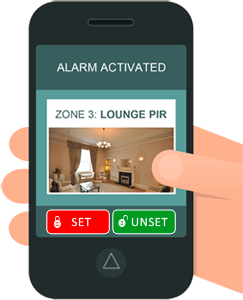Self-Monitored Alarms
We're going to throw in a newer type of monitoring here... We'll call it self-monitoring.

What are self monitored alarms?
Self monitored alarms are connected to your smartphone via an app.
Wait a minute; isn't that what a speech/gsm dialler does?
I guess the short answer is; yes...in that a dialler sends you an SMS or pre-recorded voice message, informing you your alarm has been activated, BUT THAT'S IT!
With the emergence of smart home, the security industry realised that dialler systems, with their limited functionality, were a bit old hat, and things had to evolve.
Fast-forward to 2025 and we now have options to self-monitor alarms with advanced control: Read on to find out more
There are two main methods of communication to connect your alarm to your smartphone:
IP Connectivity
By connecting your alarm system (with IP module fitted) to your broadband router, which most households have these days, unlocks a whole host of extra "self-monitoring" features.
Using IP (Internet Protocol - your broadband connection) as its communication path, alarm systems can stay permanently connected to a cloud service (a secure server somewhere in the world), maintained by the alarm manufacturer.
You, the property owner, would then download the alarm manufacturer's secure app onto your Android/iOS device, which connects securely to the cloud.
You now have single path "self-monitoring".
The biggest reason some people choose to self-monitor their alarm systems?
It removes monthly ARC monitoring costs.
But what happens if somebody switches off your router, or there's a power cut, or you have poor internet connection?
Good point!
These are all serious things to consider, but the risk is no different to any other form of single-path monitoring, i.e. if this single path goes down, you are left without live monitoring, as you would be with a Digi Comm.
While there are solutions to avoid IP outage during a mains fail, utilising uninterruptible power supplies (UPS) or routers with backup batteries, for the sake of this article we're going to assume your households, like most, don't have this type of implementation.
A properly configured alarm systems using IP as its primary communication path should send you a push notification (alert) from the cloud to your app, informing you that it has lost connection to the alarm panel.
Although there's nothing more you can do about it, until the path is restored, at least you're made aware.
There's another form of single-path self-monitoring which is arguably more robust... see 4G connectivity below.
Pros
- Often cheaper than paying monthly monitoring fees to ARC
- Uses existing technology as most households have broadband
Cons
- Can be circumvented by switching off mains
- Not reliable if you have poor internet connection
- Have to leave broadband on 24/7 (even when on holiday)
- Some alarm companies charge a cloud connection fee
Get a quick quote for a self-monitored alarm now. Quick Quote
3G/4G Connectivity
Assuming you have a strong 3G signal in your property (4G's even better, 5G would be awesome), your alarm system, with the correct GSM module fitted, can use the mobile networks to self-monitor
People consider the 3G network a more secure single-path as it's less likely to go down, or be tampered with, compared to your internet connection.
While a mains fail at your property would typically result in your router going offline, it would not interfere with your 3G signal.
A good installer would recommend a SIM card from an M2M provider, like CSL DualCom, as their SIMs will connect to any of the big 4 mobile operators. CSL's Gemini Network constantly polls the SIM and will automatically switch it onto the strongest mobile network.
The one downside; it's more expensive than using your home broadband as you need to pay the monthly fee for the SIM card.
With your alarm system now connected to the cloud, by either medium, you can now monitor and control your alarm system at the touch (and swipe) of a fingertip via the secure app. Most alarm manufacturers on the market today offer the functionality to remotely set/unset the alarm from an app as well as receive status updates. For example get notified when someone arms/disarms the system or an alarm's been triggered.
There's more cools things you can do from the app. With IP cameras connected to the alarm you could actually see what's going in your property when the alarm is triggered, but we're now getting into the realms of smart alarms.
Pros
- 3G and 4G networks are less likely to go down compared to your internet connection
- If one network did go down, the SIM would roam onto next strongest network
- Not reliant on having a fixed line with internet connection
Cons
- More expensive, when compared to IP, as there's monthly SIM costs
- May not be an option for rural locations with poor GSM signal
Get a quick quote for a self monitored alarm now. Quick Quote
So which method of monitoring is right for you?
There's no right (or wrong) answer to this.
Often the decision is based on what technology is available at your property. If you have good 3G or 4G coverage and also home broadband you have a decision of cost vs risk.
If you want to be super cautious, you can, of course, combine the two and have dual-path self-monitoring, where one would take over if communication path was lost on the other.
Broadband could be your primary path (with an IP module fitted to your alarm system) and 3G could be your secondary path (with a GSM module fitted), although this is not typically required with a residential alarm system.
Still not sure on which type of alarm to choose? Read our conclusion.